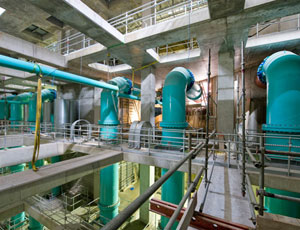Facing unpredictably tough ground conditions, tunneling crews have worked all out this year to get Belfast’s $195-million, 9.4-kilometer-long stormwater storage tunnel system operational before Christmas. With work largely done, Northern Ireland Water (NIW) aims to recruit soon a design firm to handle its second deep-tunnel sewer project, likely to be just as tough to implement.
Built to capture combined sewer overflows (CSOs), the first project will go live in December, three months later than scheduled. Given the conditions, “That isn’t too bad,” says Bill Gowdy, NIW’s project sponsor.
But delays from slower-than-anticipated tunneling rates were contained only by accelerating construction to claw back about six months of the schedule, says Paul Ronicle, project manager with the joint venture of Morgan=Est plc, Rugby, and locally based Farrans (Construction) Ltd. “We’ve been working around the clock all this year,” he adds.
With Belfast’s combined sewer system dating back to the Victorian era, “we simply can’t cope” with increased stormwater flows, says Gowdy. Extensive flooding this decade has increasingly filled streets with untreated overflows, contaminating the city’s River Lagan. The utility has been in regular breach of legal discharge limits policed by the Northern Ireland Environment Agency.
The scheme’s 19 shafts, up to 10 meters in diameter, and large tunnels will capture and store storm flows to improve river water quality by 80%, says Gowdy. With an 85,000-cu-m storage capacity, the new system allows the operator to manage the flow of stormwater into the city’s existing treatment plant in Belfast harbor, opposite the shipyard that built the steam ship Titanic.
About 15 times year, flows will exceed the plant’s capacity, and be discharged into the harbor after screening to remove large solids. Such discharges will exceed 800,000 cu m a year, estimates Gowdy.
In terms of capacity, the scheme is one of the U.K.’s first to allow for global warming, explains Alan Skates, project director with W.S. Atkins plc, Epsom. Atkins is NWI’s project manager and took the design to about 70% completion, and finalized by the turnkey contractor.
When designed the system six years ago, Atkins sized the project’s capacity for a one-in-30-year stormwater flow instead of the standard of one in 20 years. That is now the U.K. norm, adds Skates. The system’s storage capacity is 85,000 cu m.
Belfast’s tunnels follow an inverted-Y configuration that carries sewage northward to a new pumping station next to the treatment plant. Two tunnels converge from the southwest and southeast at a point near River Terrace.
One, 3.75-km-long tunnel, with a 2.44-m internal diameter, was driven by an earth-pressure-balance machine (EPB). With diameters up to 1.95 m, the second 1.8-km-long tunnel was pipe-jacked. Both feed into a 3.7-km-long, 4-m-dia bore driven by an EPB machine to the pump house. There, six pumps are housed at the bottom of a 41-m-deep, 37-m-dia concrete-lined pit. With one pump on standby, the other five can lift 16 cu m per second of wastewater to the surface for screening and discharge. The contractor is now doing finishing work at the pump house and collector shafts, having completed tunneling a few months ago.
Boring some 30 m below ground, the two EPB machines were “configured...to deal with boulders rather than for...



















Post a comment to this article
Report Abusive Comment